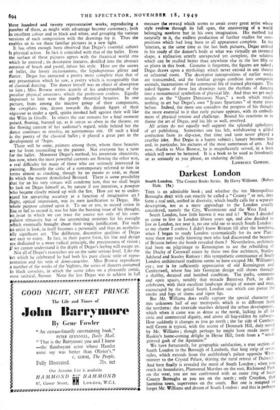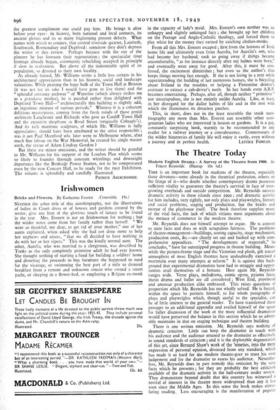Darkest London
South London. The County Books Series. By Harry Williams. (Robert Hale. 15s.) THIS is an admirable book ; and whether the ten Metropolitan Boroughs dealt with can exactly be called a " County " or not, they form a real unit, unified in diversity, which loudly calls for a separate description, not as a mere appendage to the London usually considered, namely the City, Westminster and the West End.
South London, how little known it was and is! When I decided to come to live in London fifteen years ago, and also decided to live in London, not near it, no one told me to starch South London: to my shame I confess I didn't know Brixton till after the bombing, when I began to study London systematically for its new Plan: were there any really knowing men who had discovered the beauties of Brixton before the bomb revealed them ? Nevertheless, architects had been on pilgrimage to Kennington to see the rebuilding of the Duchy of Cornwall estate by those two fine architects, Stanley Adshead and Stanley Ramsey: this sympathetic continuance of South London architectural tradition seems to have escaped Mr. Williams's eye ; nor is he sufficiently appreciative of old Kennington and Camberwell, where fine late Georgian design still shines through a shabby, decayed and bombed condition. The parks, commons and open, spaces, notably that miracle Battersea Park, he duly celebrates, with their excellent landscape design of nature and man, encouraged by the genial South London sun which can pierce the smoke and fogs of slums and ripen figs. But Mr. Williams does really capture the special character a this unknown half of our metropolis which is so different from the northern: the riverside marshes delayed the urban development, which when it came was as dense as the north, lacking in all its civic and commercial dignity, and above all hag-ridden by railways. How suddenly it changes as you go north ; the far side of Camber- well Green is typical, with the ascent of Denmark Hill, duly noted by Mr. Williams ; though perhaps he might have made more of Ruskin's home-coming delight in Herne Hill, fresh from a "wind- grieved gash of the Apennine." We have fortunately, for geographic satisfaction, a true section of South London in the Borough of Lambeth, that long strip of seven miles, which extends from the archbishop's palace opposite West- minster to the Crystal Palace, skirting the rural retreat of Dulwich. And here finally is revealed the merit of South London ; when You reach its boundaries, Plumstead Marshes on the cast, Richmond Park on the west, you are not confronted with an outer ring of huge County Boroughs as you are on the north ; only Croydon, that harmless town, supervenes on the south. But one is tempted to forget Mr. Williams and dream of South London: and this is perhaps
the greatest compliment one could pay him. He brings it alive before your eyes: its history, both national and local contacts, its ancient glories and its so many frightening present defects. What names with which to conjure, that central riverside quartet, Lambeth, Southwark, Bermondsey and Deptford : somehow they don't depress the writer of this review. Perhaps because with the eye of the planner he has foreseen their regeneration ; the spectacular river frontage already begun, community rebuilding accepted in principle if slow in realisation. But above all the indomitable spirit of its population, so devoted to their own locality.
As already hinted, Mr. Williams seems a little less certain in his architectural appreciation than in his historic, social and landscape valuations. While praising the huge bulk of the Town Hall at Brixton (it was not for its sake I would have gone to live there) and the " splendid entrance archway " of Waterloo (which always strikes me as a grandiose misfire), he is puzzled rather than delighted with Deptford Town Hall—" architecturally this building is slightly odd, an ingenious mixture of various periods." Whereas it is a coherent delicious masterpiece, coming from the fresh minds of those genial architects Lanchester and Richards who gave us Cardiff Town Hall and the exatiis•ite shopfront in Bond Street (originally Colnaghi's). And its rich maritime sculpture, of which Mr. Williams is fully appreciative, should have been attributed to the artist responsible ; was it not Paul Montford MK• later went to Melbourne where, after much fine labour on the War Memorial, he created his single master work, the statue of Adam Lindsay Gordon ?
But these are minor omissions, and the writer should be grateful to Mr. Williams for his support of the London Plan which seems so likely to founder through constant whittlings and downright departures like the Banks* Power Station, not to be compensated even by the new Concert Hall, to be ready for the 1951 Exhibition. The volume is splendidly and candidly illustrated.
PATRICK ABERCROMBIE.















































































 Previous page
Previous page